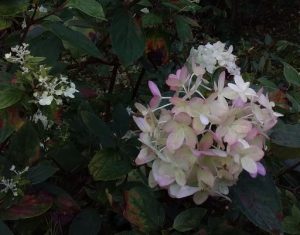November Gardening Tips
The colour of trees in the garden and wider countryside turns to gold, red and bronze, quite lovely on a sunny day. The ground beneath looks gold plated.
I am not fastidious about raking leaves up immediately – they will do no harm for several weeks and will provide food for worms. Left too long, they will start to damage grass and provide slug heaven, so I will have to pick them up and make leaf mould!
Dead leaves in the pond should be removed with a rake or net, but leave some as a habitat for invertebrates. Put the extracted leaves near the pond for a day so that any creepy-crawlies can get back into the water.
At this time of year, the fruiting bodies of fungi (toadstools) are visible. It is worth remembering that leaves are broken down mainly by fungi, liberating nutrients. The vast network of tiny tubes (mycelium) from which the toadstools arise is of great importance to the health of trees and shrubs. They live in a mutually beneficial relationship with the roots, increasing surface area for the uptake of water and nutrients. More is being discovered all the time. Fungi mostly only colonise a plant that is already damaged or stressed.
Jobs to do

Regularly check stored apples for rot
Greenhouse: clean the glass to maximise light. The RHS says to disinfect staging and pots, but, if you have biological control agents, e.g. Encarsia wasps for whitefly, this will wipe them out and you have to start them again.Jobs to do
Kitchen Garden: When the leaves are down then you can start pruning fruit trees except plums. Remove dead, diseased and crossing branches. I’m told a pigeon should be able to fly through the tree when you have finished! Cut side shoots back to two buds and leaders to six.
Currants should be pruned to give an open structure. Take cuttings from the prunings: strip off lower buds and push into soil to a depth of 6 inches (15cm).
Grapes can be pruned after leaf-fall but before the end of December
Sow broad beans and plant garlic cloves now. The cloves should have their tips 3-4 cm below the soil surface, 15 cm apart and 30 cm between rows. Overwintering in the soil at less than 10o C for 1 or 2 months means it develops good bulbs.
Ornamental garden: Prune Acers, put grit round alpines to stop rot, plant tulip bulbs. Raise pots on pot feet to prevent waterlogging. Leave ornamental seed heads as food and shelter for wildlife
Protect tender plants from frost:
- Heavy mulching in situ e.g. Agapanthus, Phygelius
- Lifting bulbs, corms and tubers and dry in a frost-free place e.g. Dahlia, Canna and tuberous Begonia
- Wrapping with horticultural fleece after packing lower stems with dry straw e.g. bananas, tree ferns
- Bringing pots under glass for the winter

Hydrangea paniculata flowered late this year and should last into November, getting pinker all the time
Visit Winkworth Arboretum for Autumn colour, open National Trust all year 10am-6pm, except Christmas.